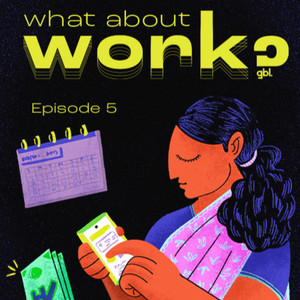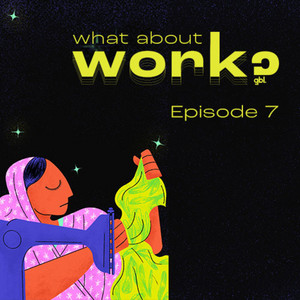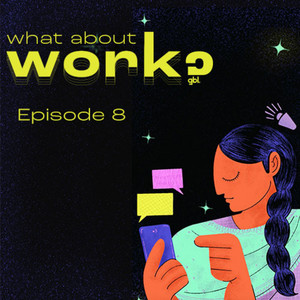What about work? is back after a mid-season break! In today’s episode, we try to explore if rural women can’t travel to work, can work, travel to them? Listen anywhere you get your podcast fix!
We explore the many complexities of rural women’s work and their declining labor force participation. Women face multiple obstacles in accessing work, including the lack of mobility, lesser opportunities and childcare.
Tune in to hear from the folks at GBL on their experiences of fieldwork in Jharkhand, India for the project FLS, Female Labour Supply:, which sees in the problem of rural women’s labor participation one path of formal, flexible work.
Transcript
Hello! And welcome to What about work? An audio series produced by Good Business Lab.
Good Business Lab seeks to globally transform the lives of low-income workers through rigorous research and evidence-based solutions.
What about work? talks about the past and current experiences of workers in labor-intensive industries and other emerging sectors from different geographies. Be it garment, automobile, fast food, platform gig work or any other.
And we are back from our mid-season break! This season has been dedicated to low-income women workers in labor-intensive contexts. Their struggles, their ambitions, their stories.
In our sixth episode, we are taking a step away from the humdrum of the city and moving towards the hustle and bustle of the village. Today, we will take a look at women’s access to paid employment in rural India. The challenges they face, the possibilities that could unfold, and everything in between.
Kanika Mahajan is an Associate Professor of Economics at Ashoka University. Listen to her unpack the many complexities of rural women’s work.
Kanika M: So, in terms of women’s labor force participation in India, we know that there are huge gender gaps to begin with. In rural India, in the same age group, the labor force participation rate of women has declined from 54% in 1987 to about 31% in 2017. That’s a huge decline. That’s almost like a 40% decline. In urban India, it has been almost stagnant though there’s a slight decline from 26% in 1987 to 24% now. So I think the main broad point is that in urban India, women were always less likely to work and that has sort of remained as is and probably slightly only worsened over time. Whereas for rural women, it’s definitely worsened over time.
Why is it that urban areas are so far for India’s rural women?
Mansi Kabra, Associate Director of Marketing and Transformation at Good Business Lab or GBL, says,
Mansi K: Rural women in particular, they are constrained by rigid social norms and are unable to travel outside, outside of their village and they struggle to find, you know, opportunities for employment.
Professor Mahajan adds that even when they do travel things continue to be for the most part out of their control.
Kanika M: So amongst all the migrants, which were women, only 2% had migrated in search of jobs, whereas almost 98% had migrated, either because of marriage or because their partner had moved, location or their parents had moved location. However, that’s not to say that women who migrate don’t work. So the primary reason to migrate, maybe, you know, moving with the husband is because the husband got a job. And, you know, sometimes they start looking for work wherever they migrate to, even if the initial reason for me, you know, to migrate is not themselves looking for work. And when they migrate along with their husbands or along with their families, they’re less likely to work as compared to other urban women who are, you know, who have been living in that location for long and this is something that has borne out in village level studies as well.
Sanchita Wadhwa: childcare is a big thing. Mostly things that are coming out for women is that, you know, I cannot leave my child behind or there’s nobody else to take care of my child, which is why it would be difficult for me to step out of the house and work.
That was Senior Research Manager at GBL Sanchita Wadhwa. You’ll hear more from her soon.
Coming back to women’s manufactured dependency on their natal or marital families. This often means that rural women cannot choose their own domain of work, instead relying on what’s most easily available and permissible for them.
There’s a reason that Professor Mahajan’s figures show urban India to be historically lagging behind rural areas in women’s employment. As Mansi states, mobility and access are key issues women face when making decisions about their work.
During the early stages of one of GBL’s many research projects focused on gender, Mansi spoke to one particular rural woman who
Mansi K: drew a metaphor of the many borders that exist for women that distance them from accessing different opportunities and how women have to put up a fight to cross each and every border. So she mentioned how the first border is the border of your own house, the doorstep, then you have to cross village borders, then you have to cross nearby village borders, then going to the district capital and finally huge cities. And that metaphor, that picture is, was pretty stark the way she drew it.
A bordered life. That is the story of women across the country.
Mansi K: But it was also that the time spent commuting was seen as extremely wasteful in comparison to the amount of money women brought back. So it was a very, very layered way of explaining the different problems women face. Then there was another woman who brought up the theme of security. It was very bittersweet because she mentioned how the media promotes fear. But the same media also displays women as having a life outside of the home.
The problems are many. But can there be any possible solution?
Mansi K: We were very curious in the team that if distance is one of the, you know, important deterrents that’s preventing women from accessing work opportunities. And if they can’t travel to work, can work, travel to them?
In one sense this isn’t a radical question to ask. We all know of a time when work and not workers traveled. The Coronavirus pandemic. A global health crisis that forced us all to ask one question: what about work?
For white collar workers, despite a few hitches and bumps- the home became the workplace. Zoom meetings substituted real ones. Slack replaced dragging your chair to your colleague’s cubicle. And I’m sure many traded in the desk for the sofa or the bed.
But was this also the experience of workers in labor-intensive contexts?
Good Business Lab co-founder and CEO Anant Ahuja says,
Anant A: that same thinking hasn’t fully transferred to manufacturing jobs [..] in a garment factory, for example, the way that the shift works is there’s very specific times for when you start and finish. And the reason for that is because it’s team based work in an assembly line, which is how a lot of large garment factories function, you can have anywhere from 20 to 40 or maybe even more people in one team in one line. And they are essentially, you know, sitting in a formation where each person can, can work on one single operation. for example, attaching a sleeve or attaching a collar and just focus on that operation. And then once they’re done, they hand it over to the next person in the line in the team who can do the next operation. And so because of the team based kind of set up it’s traditionally been the case that everyone has to work from the same place. 13:08 No one was thinking about, no one really had the ability in that moment. At least to think about how do we reimagine some of these jobs? Could any of this work be done from home?
What feels seemingly unthinkable is not that far from the realm of possibility. We started this season with a story about a woman from British India who earned her income by spinning cotton at home. ‘Work from home’ as we say now. Many women are enmeshed with the informal sector even today, carrying out small-scale activities in local setups. Whether that’s taking up tailoring orders of their own, engaging in street vending, or a litany of other home-based work. These are important outlets for many women. But labor participation rates still spell a bleak present for women in India. So how can this square with the demands of formalized sectors?
Manufacturers have arranged the supply chain such that moving closer to the site of the factory is seen as the need of the hour. And while that seems easy enough to accomplish, for women in rural India as we have seen this makes things tricky.
The informal sector can be more vulnerable to volatility and crisis. Women in Informal Economy: Globalising and Organising found in its 2022 report that home-based workers were some of the most affected by the pandemic.
The report says,
Paridhi A: Median earnings in mid-2021 for home-based workers are still zero, unlike the other sectors where there has been some recovery of earnings. There has been a staggered and uneven recovery among waste pickers, domestic workers, home-based workers and street vendors in average number of days worked, and earnings for workers continue to be below pre-COVID-19 levels in all sectors.
So if the informal sector is unpredictable and can saddle women with losses, is there an alternative? Can women enter the formal sector despite the lack of mobility?
GBL began investigating the possibilities of designing home based work as an alternative to the dominant supply chains for labor-intensive industries.
Sanchita W: What we’re trying to do with the project is see whether providing flexible work opportunities to women in rural India can actually increase female labor force participation.
Madhukari Mishra : the idea here is to see that can flexible workers like when you are at home and you can like work at your own pace and on your own time, will that increase labor force participation 2:09 for women?
Senior Research Manager at GBL Sanchita WadhwaSanchita again. And Madhukari Mishra, Senior Research Associate, were part of a GBL project, Female Labour Supply: Scaling Models of Decentralizing Production or FLS.
The project attempts to enable women’s access to paid work.
Anant A: To engage in home based workers is very interesting.I think it’s very valuable.
The FLS project sees in the problem of women’s labour participation one possible answer of stable, flexible work.
Some 50 kilometres north of Jamshedpur, in the northern Indian state of Jharkhand, lies Nimdih. Like Sanchita and Madhukari who you heard earlier, Madhu Manjunath who is Senior Design Associate and Deborah Charles, Qualitative Researcher at GBL, also traveled to the village to conduct research for the project.
Deborah C: So we leave in this car and we’re driving down this 90 minute journey which you have like these long winding roads. It’s not, it’s not like just a highway, it’s like really long winding roads and there are parts where there’s nothing but like agricultural land. And there’s, there are parts where there is just a like forest type of area. There are parts where you go through tiny villages.So you see like smaller villages as well and for some reason, they were always like a lot of things were always like low on activity. There’s not a lot of people like about you probably see stray cattle here and there or you see people mostly in the farm, like one or two people.
Madhu M: you know, to get there, we actually had to cross through a very famous lake. So we had to cross the lake and even National Park I believe, you know, we had to cross through forests and there were hills. And it was very interesting to find that there were a lot of houses being built or at least on the road that we were traveling in. We were also informed that that’s one of the main jobs that many men take up in the construction sector. It was also located very close to a train station.
Before any intervention, it is important to understand the context of a particular community. Research, after all, cannot create impact from glass domes. It is only when you root the work into the life of those whose concerns and inputs have not historically been valued that you can effectively transform conditions of inequality.
Sanchita recounts their Nimdih visits in March to assess women’s interest in the project,
Sanchita W: In March was when me along with Priyanka, who’s the research fellow on the project, both of us did like a short scoping visit to just understand the dynamics and the characteristics of women in the area. what we understood from just talking to these women was that, you know, they were all interested in being part of this project because they do want to work, but they don’t have any opportunity in the village. 7:21 The closest city is like, which is almost like one and one and 1.5 to 2 hours away.
Fast forward to June, 2023.
Sanchita W: We just did like a short baseline survey, a pilot baseline survey. The pilot is happening with 50 women. And it was quite interesting, like our baseline survey basically sort of asked about different things about women experiences, their educational backgrounds. Have they ever worked before? Would they like to work? What are the gender and social attitudes in the area?
As part of the pilot, a group of 50 women were trained to weave home items from sabai grass. Widespread in the region, sabai grass can be used to build furniture, baskets, coasters, even pulp which can be raw material for rope.
The grass is a natural fiber and can be smoothly bleached and dyed and braided and handled.
Madhukari M: It’s a grass that you can see growing in the plateau area like it’s easily accessible for the people there. you know, when you do a pilot and then especially when you see what I what interested in after going when I saw that the women who turned up for the training, they were so excited to learn a new skill.
So what does this training actually look like?
Madhukari M: So our implementation partner is this organization called Bangla Natak. So for example, they got their master trainers in sabai from a district called Shara. And it was sheer coincidence, apparently the village from where all the master trainers came, like this place called, happens to be very close to my ancestral village. So that was like a funny coincidence for me. Anyway, so the thing is the a where they were like training, it was such a nice place like it had this infrastructure like, you know, like a proper building where they can train the women and the kids like, and it was like surrounded by a mango orchard and the kids would go around collecting mangoes while their mothers would be learning this thing.
Deborah C: And you have a whole lot like around 50 women just sitting there and they have all these like stationary around them like scissors and the, the grass that they’re using, the sabai grass that they’re using to make their products. And then there’s a lot of chatter, there’s a lot of like babies, you know, laughter and crying and like babies in the sand playing like a lot of that going on then to the left.
Madhukari M: So they had this rough structure and they were just learning how to wrap the rope around the structure and then weaving it into itself and things like that. And then they said that the main intricacy comes or the technical part comes is like when you learn how to dye this rope and then incorporate that into the rest of the work. So basically, in that way, you are making patterns and textures. And the second day I actually saw this dying happen. So like they had this huge pot in which they boil the water and put the dye and the rope and it was quite interesting, It’s completely handmade without any machine. So it’s something that women can actually do I mean, you don’t need a lot of initial capital to do.
Trainings can be an immersive space for women to share time with each other. This is a theme we have explored in some of our previous episodes. For some, it can be a learning experience they may not have had access to before. For others, it could be like returning to environments they cherished but are unable to move towards in the present.
Sanchita W: I also met a woman who’s done like post post graduation, but none of them are doing anything. They’re just sitting at homes because 9:07 there’s just no opportunities.
This looming gap is troublesome also because as Professor Mahajan says,
Kanika M: Because as your education increases, your productivity at home increases, I can take care of my children better, right? I can teach them at home.
And yet The potential positive outcomes of higher education are lost for many rural women.
This project hopes to not only bring paid employment to rural women’s own doorsteps but also build an understanding of whether such market linkages can support them in gaining a sense of security and independence.
Sanchita W: But we want to get some buyers on board who will want to buy the product that is produced during the implementation during the project itself, not just the pilot, but also the main study which will actually run for almost a year once we start with it, so they would purchase the product and all the like whatever is purchased or whatever the price it goes back to the women who sort of make the product. 13:01 So we are hoping that these women also, once they get trained, should have some sustainable employment in the future.
There are several consequences that could arise from a step in the right direction. Once women start taking on the role of active earners rather than passively contributing to household earnings through unrecognized work, the likelihood of community attitudes towards women working could also improve. Not to forget, becoming financially independent can be an important measure to empower women while also protecting them from situations of abuse.
Rigor is key to our research. So of course, we understand there are specific caveats and considerations to projects like FLS.
Anant A: There’s obviously aspects of well being that can improve from working at home. There’s also aspects of well being that you miss out on if you work from home. So just as an example, I’ve heard many stories about garment workers in factories saying that coming to the workplace for eight hours a day or for a shift, it essentially for some people is an escape. It’s, it’s an opportunity to not be, you know, if they’re feeling trapped at home to have a place to go, that’s not that environment to have the freedom to actually meet other people and maybe even meet peers who you relate to and, and and wouldn’t have had the chance to interact with and share your experiences and build support networks and, and social networks.
And women have an intimate knowledge of how confining the domestic space can be.
Madhukari M: Some women said something very interesting that even if you’re working from home, there could be constraints like this, you know, you are called to do this and that basically you are expected to attend to and prioritize household chores.
That is why
Madhu M: Once their training is complete and some women from the same group will have to come back to the training center every day for work that we identify whether they want to work from home or work from the community level or what they really prefer.
It is important to note that not every woman will have the same aspirations, or the same path she wants to take for achieving her aspirations. But what this project is trying to do is unlock one possible path for women who may want to choose it.
In the next episode, we will explore more about Nimdih women’s responses to the project, what research insights could this provide, and the impact FLS could create. We hope you enjoyed today’s episode! Catch you next time!
Thank you for listening to What about work?.
We always welcome constructive feedback. Have anything you want to say? Drop us a message @goodbusinesslab on Twitter, Instagram, or LinkedIn. You can also visit our website goodbusinesslab.org to learn more about our approach to worker wellbeing.



